Each of the recommended rule changes included in the RWVL petition to the Vermont Agency of Natural Resources is supported by science. Here is a summary of each:
• Keep wake surfing 1000 feet from the shore.
The three leading researchers on wave action and water quality, who have measured the effects of wake-surfing on lakes, all recommend that such boats operate far from shore. Jeffrey Marr of the University of Minnesota recommends “over 600 feet;” Yves Prairie of the University of Quebec, and Sebastien Raymond of the University of Laval, both recommend “at least 300 meters (984 feet).” (For details see the RWVL petition pages 13-24.)
Numerous studies have measured wakes produced by wake surfing boats and how they decrease with distance. Wakes consist of a series of individual waves referred to as a “wave train.” The most important wave train parameters include maximum wave height; total wave train energy; and peak wave train power. Power is considered the most important parameter because of its harmful and destructive impact on the shoreline, other boaters, swimmers, water quality, and wildlife. Key studies in this area include:
Wave Power – A Simple Analysis
Defining boat wake impacts on shoreline stability toward management and policy solutions
The most recent research, conducted at the St. Anthony’s Falls Laboratory at the University of Minnesota, measured the wave energy of a wake-surfing boat at 500 feet from shore to be twice that on a water ski boat at the same distance. An offset of 500 feet is not enough to dissipate the harmful energy of a surfing wake. The wake boat would need to be 1000 feet from shore to be safe.
Digging deeper into the science, Vermont rules currently call for any motor boat going more than 5 miles an hour to stay at least 200 feet from shore, docks, boaters, swimmers, and moored boats. The University of Minnesota study measured the power of wake boat wakes, compared with normal waterski boat wakes, at various distances from the shore. The study found that a wake boat 600 feet from shore (the furthest they measured) exerted more destructive power than a waterski boat at 200 feet. Extrapolating the Minnesota data, we conclude that the wake boat would need to be at least 700 to 1000 feet from shore before its wave power equalled that of a normal waterski boat at 200 feet.
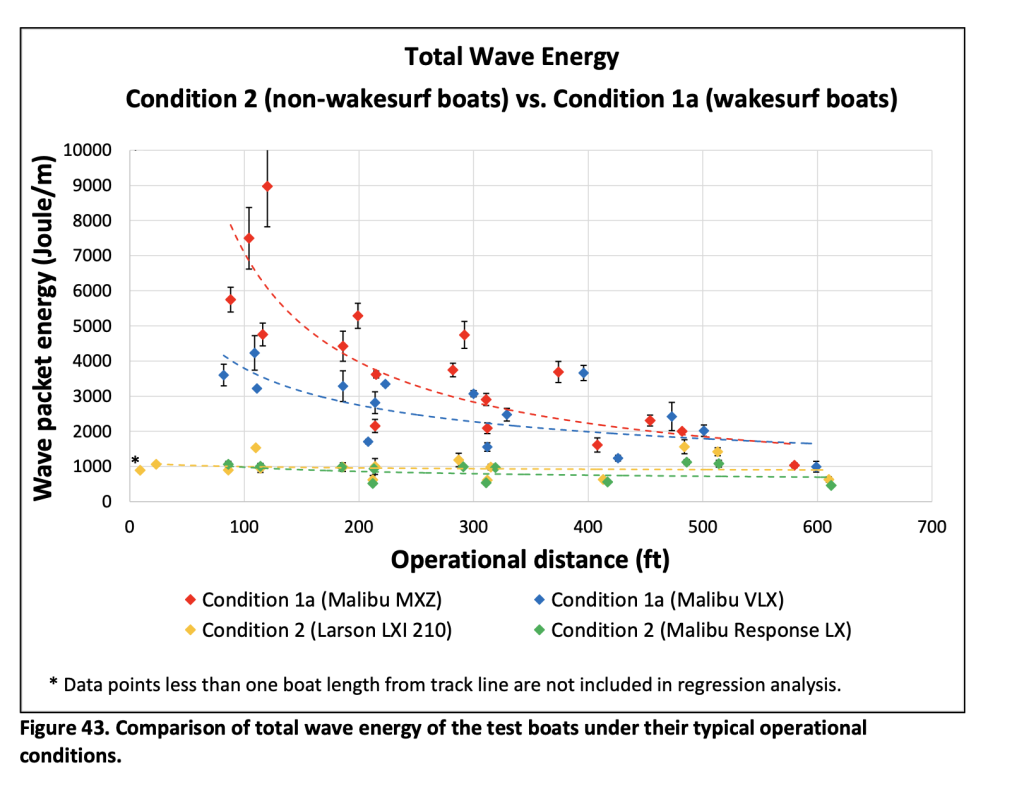
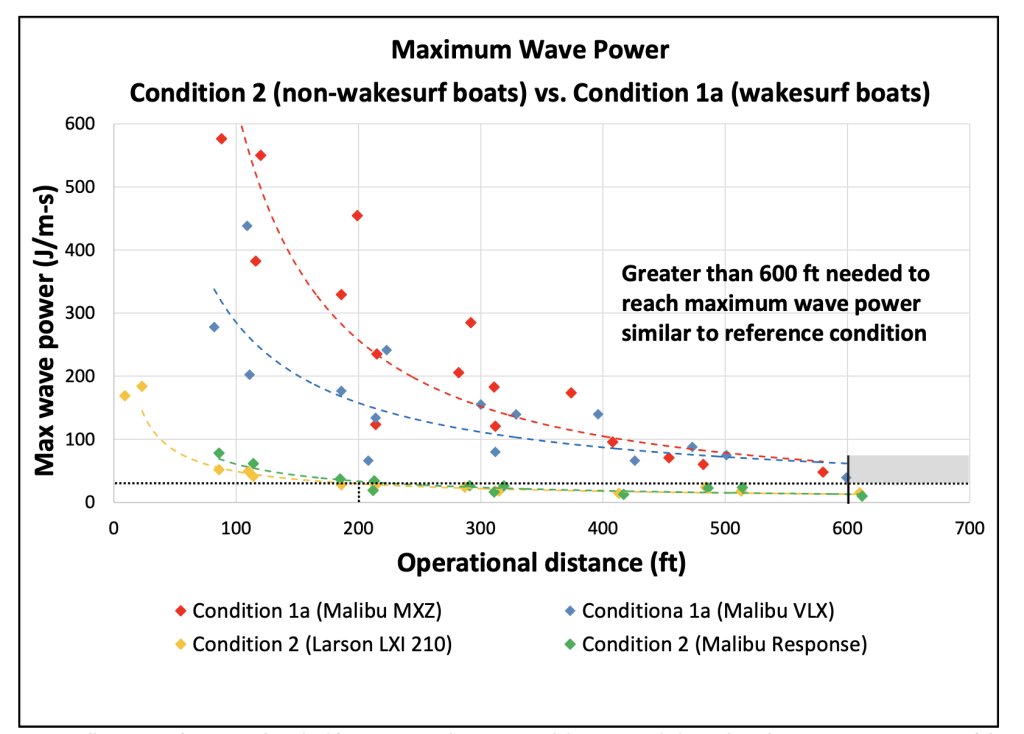
Another study on Lakes Memphremagog and Lovering conducted by the University of Quebec measured the wave power of a ballasted wake boat at 11 miles per hour, and an unballasted boat traveling at waterski speed of 30 miles per hour, at various distances from shore. They found that a wake boat at 656 feet (the furthest they measured) exerted twice the destructive power of a ski-type boat at the same distance. Extrapolating the Quebec data, we conclude that the wake boat would need to be at least 1000 feet from shore for its wave energy to dissipate to normal levels, and at least 700 feet from shore before its wave power equalled that of a normal waterski boat at 200 feet. The authors of this study recommended to the Canadian authorities that wake surfing should be allowed only in waters 984 (300 meters) feet from shore.
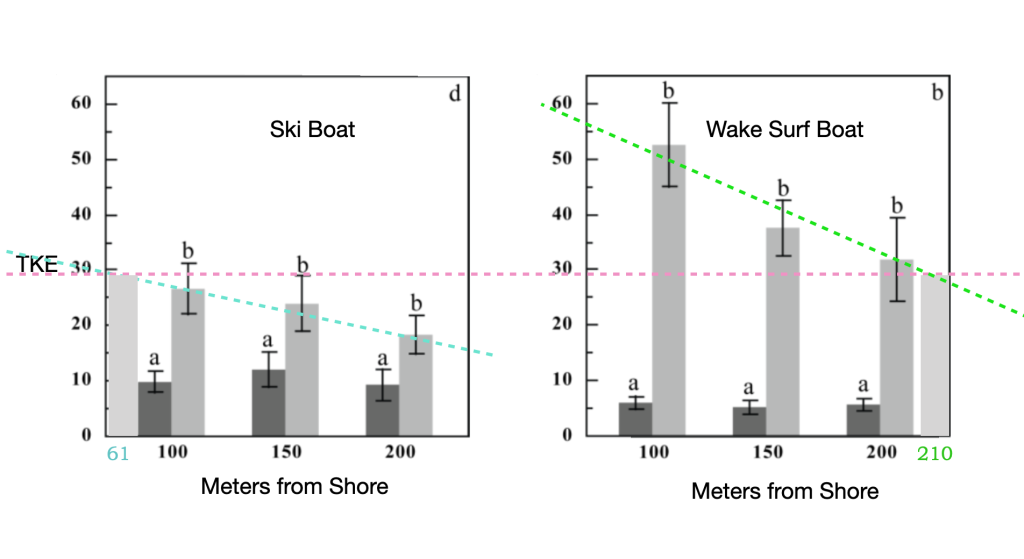
A study conducted on the Willamette River in Oregon by Tasmanian researcher Gregory Macfarlane also measured the wave height of a surfing boat at 400 feet to be twice that of a ski boat at the same distance. Partly as a result of this study, the authorities in Oregon have banned wake surfing completely from a 25-mile stretch of the river.
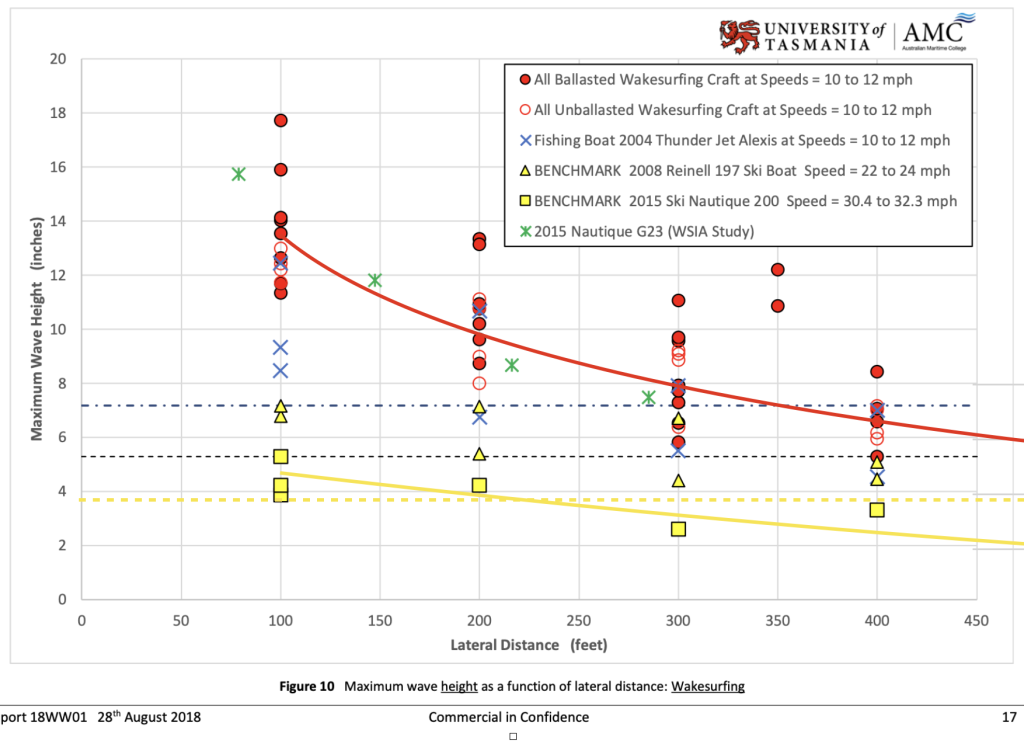
All three studies used older wake boats that were lighter, carried less ballast, and ran less powerful engines than the wake boats currently being sold. Because the trend toward heavier and more powerful wake boats is likely to continue, and because Vermont’s current 200-foot shoreline safety zone has proven inadequate in preventing shoreline damage as well as near-shore water quality degradation, we conclude that wake surfing on Vermont Lakes should be restricted to areas at least 1000 feet from shore.
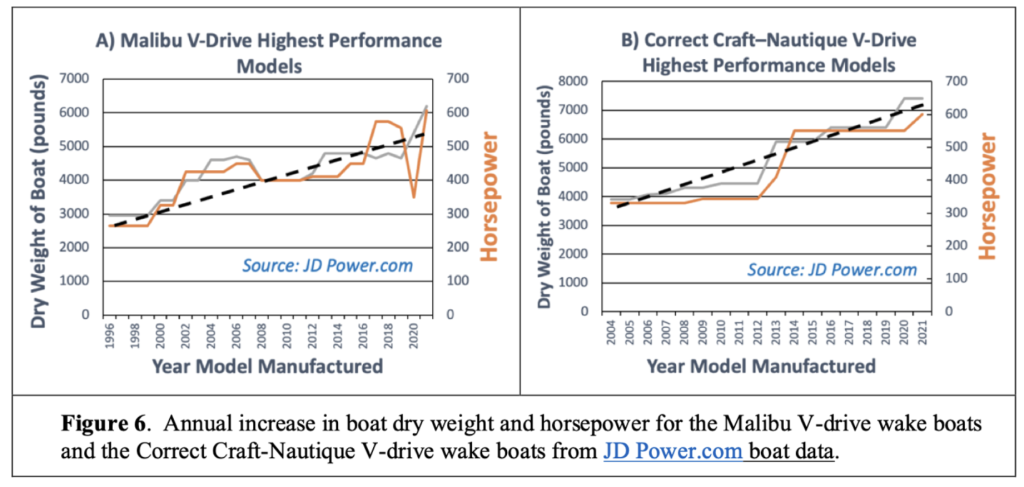
- A Field Study of Maximum Wave Height, Total Wave Energy, and Maximum Wave Power Produced by Four Recreational Boats on a Freshwater Lake
– Audio Interview with Jeff Marr, University of Minnesota
• Restrict wake surfing to water more than 20 feet deep.
Motorboats operated in shallow water can stir things up as propeller wash and underwater wakes scour shallow lake bottoms. With engines of up to 600 horsepower and downward-directed propeller currents, wake boats operating in wake surf mode—far more than other motorboats—can uproot and fragment aquatic vegetation, while also disrupting normal underwater plant and animal life, and dispersing bottom nutrients such as phosphorous and nitrogen that contribute to algal blooms.
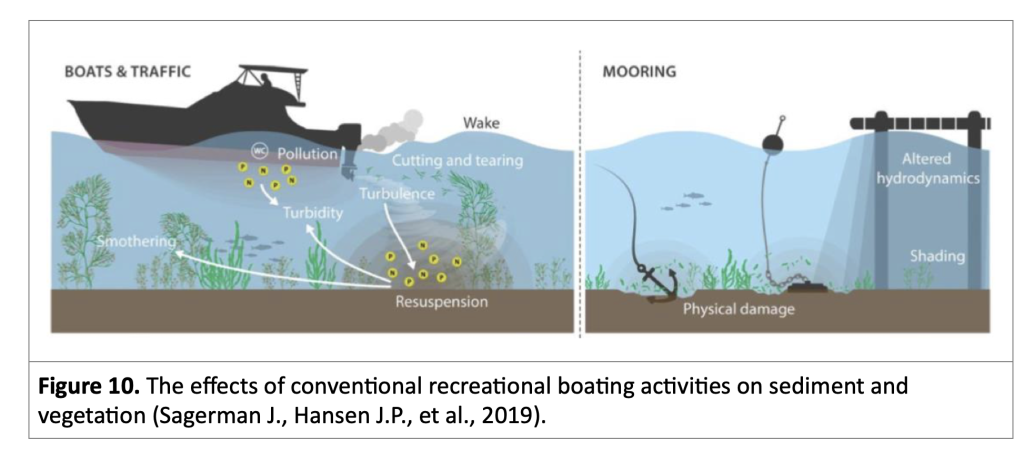
Several studies have measured the turbulence of wake boats at various depths. A study by the University of Western Colorado found that wake boats produce propeller turbulence velocities sufficient to raise fine nutrient-rich sediments — like those found on many Vermont lake bottoms — at depths greater than 20 feet. The University of Laval study found turbulence from wake boats 5 meters below the surface. Because most of the vulnerable “littoral zone” of Vermont lakes is in depths less than 20 feet, this minimum depth requirement would help protect the critical bottom lake habitat. Imposing a 20-foot depth limit would help prevent these adverse wake boat propeller-induced impacts on plant and animal life, including algal blooms.
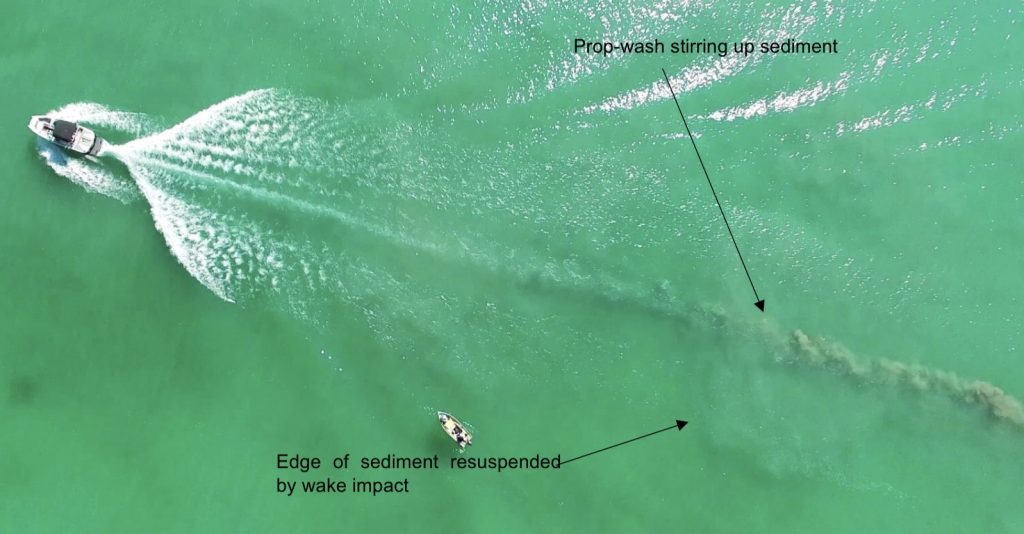
• Set a 60-acre wake-surf zone
Safe wake surfing needs room to maneuver far from the shore, swimmers, and other boaters. And wake surfing needs a straight run of several thousand feet to be safe and enjoyable. A 60-acre zone provides the minimum area consistent with safety and enjoyment.
Unlike most motorboats, wake boats produce large and powerful wakes that threaten the safety and enjoyment of others engaging in normal recreational water uses such as waterskiing, cruising, sailing, kayaking, canoeing, rowing, paddleboarding, fishing, and swimming. To address these concerns while allowing wake boat enthusiasts adequate space to enjoy wake sports, we have proposed the creation of 60-contiguous-acre minimum Wake Sport Zones.
In developing the basis for our proposed 60-contiguous acre minimum Wake Sport Zones several factors required for adequate wake boat operation were considered. These include the necessary watercraft speed, time and distance for a safe and enjoyable ride along a straight pathway. To generate a surfable wake, wake boats typically operate at 11.5 mph. Normally, wake boats travel in a straight a line while generating enhanced wakes for wakesurfing (Richman D., 2019) and wakeboarding (MonsterTower, 2020).
A 60-acre zone, round in shape, would provide a straight run of 1825 feet, enough for a 90-second run over a straight course. Anything less would be too short to enable the driver to get the boat up to speed and shape a rideable wave, while the rider positions the board, stands up, approaches and tests the wave while holding the rope, lets go the rope, enjoys some surfing, and then ends the run as the boat slows near the end of the zone.
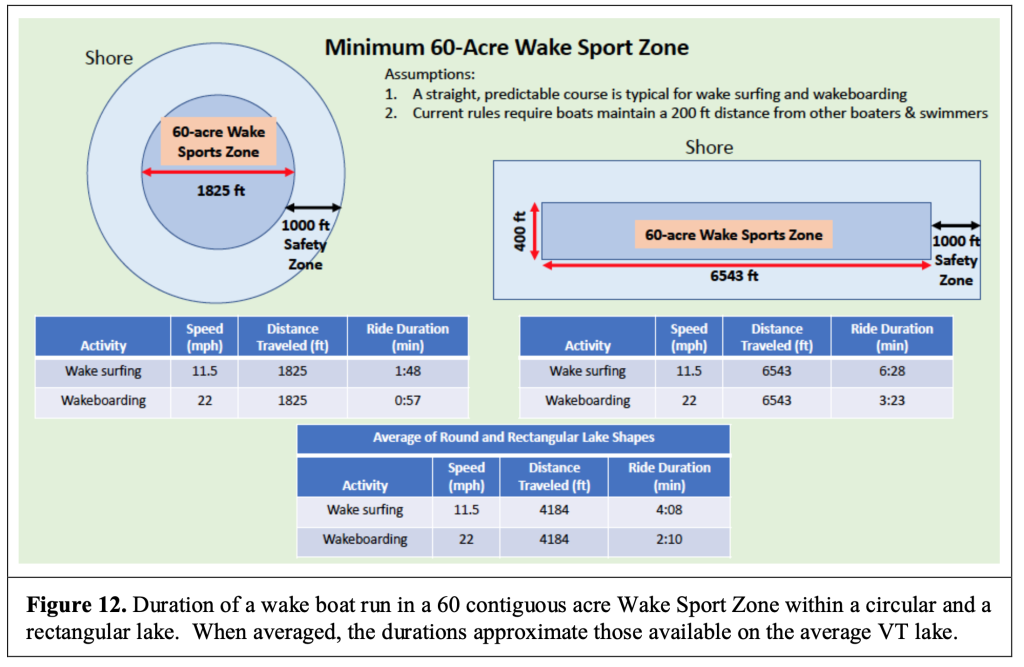
- How to drive a wake boat for wakesurfing, by D.Richman
- Learn to Wake Surf
- How to Wake Surf: Ballast 101
- Wakesurfing 101
• Prohibit transport of aquatic invasive species in ballast tanks.
Ballast tanks are a major cause of the spread of AIS between lakes, because the ballast tanks of wake boats cannot be emptied completely. Invasive species from one lake can be introduced into another from the residue left in the tanks. Wake boats that remain on one lake season after season do not spread AIS; other boats with ballast tanks will need to be decontaminated before being launched in another lake.
- Eurasian Water-Milfoil, Ontario Invading Species Program
- Ballast Water Monitoring, United States EPA
- Protect Your Waters from Aquatic Invasive Species Clean. Drain. Dry., New York Department of Environmental Conservation
- Ballast Water Treatment: Eurasian Milfoil, Eleanor Stapleford
- Engineering Seminar: Defending the Great Lakes, University of Wisconsin,
- Ballast Water, USDA National Invasive Species Information Center,
- Wake boat ballast bags can harbor invasive species, Michigan State University, 2016,
- Volume and contents of residual water in recreational watercraft ballast systems, Management of Biological Invasions 7(3):281-286, January 2016,
- Impacts of Motorized Craft on New Hampshire’s Waterbodies, New Hampshire DES,
- Low-Speed Boating . . .Managing the Wave, by Doug Keller, Aquatic Habitat Program Manager with Indiana DNR – Division of Fish and Wildlife, North American Lakes Management Society,
- Ballast/Wake Boats: Specific Concerns About Aquatic Invasive Species & Water Quality, Amy P. Smagula, Limnologist
- Wake Boats, AIS, and Water Quality, NH Department of Environmental Services,
- Annual Losses to Great Lakes Region by Ship-borne Invasive Species at least $200 Million, David Lodge, University of Notre Dame; David Finnoff, University of Wyoming ,
For a thorough explanation of the rationale and science behind the proposed rule, please consult the RWVL Petition.
The wake boat industry has claimed that the St. Anthony Falls Laboratory study contains several myths. RWVL has studied their claims, and released a report that rebuts their arguments.
